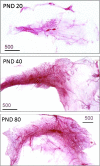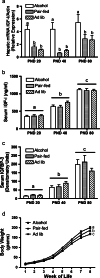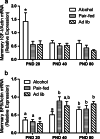Alcohol exposure in utero leads to enhanced prepubertal mammary development and alterations in mammary IGF and estradiol systems
- PMID: 21761112
- PMCID: PMC10358087
- DOI: 10.1007/s12672-011-0074-6
Alcohol exposure in utero leads to enhanced prepubertal mammary development and alterations in mammary IGF and estradiol systems
Abstract
Exposure to alcohol during fetal development increases susceptibility to mammary cancer in adult rats. This study determined if early changes in mammary morphology and the insulin-like growth factor (IGF)/estradiol axis are involved in the mechanisms that underlie this increased susceptibility. Pregnant Sprague-Dawley rats were fed a liquid diet containing 6.7% ethanol (alcohol), an isocaloric liquid diet (pair-fed), or rat chow ad libitum from days 11 to 21 of gestation. At birth, female pups were cross-fostered to ad libitum-fed control dams. Offspring were euthanized at postnatal days (PND) 20, 40, or 80. Animals were injected with BrdU before euthanasia, then mammary glands, serum, and livers were collected. Mammary glands from animals exposed to alcohol in utero displayed increased epithelial cell proliferation and aromatase expression at PND 20 and 40. Mammary IGF-I mRNA was higher in alcohol-exposed animals relative to controls at PND 20, while mammary IGFBP-5 mRNA was lower in this group at PND 40. Hepatic IGF-I mRNA expression was increased at all time points in alcohol-exposed animals, however, circulating IGF-I levels were not altered. These data indicate that alcohol exposure in utero may advance mammary development via the IGF and estradiol systems, which could contribute to increased susceptibility to mammary cancer later in life.
Conflict of interest statement
The authors declare that they have no conflict of interest.
Figures






Similar articles
-
Fetal alcohol exposure increases mammary tumor susceptibility and alters tumor phenotype in rats.Alcohol Clin Exp Res. 2010 Nov;34(11):1879-87. doi: 10.1111/j.1530-0277.2010.01276.x. Alcohol Clin Exp Res. 2010. PMID: 20662802 Free PMC article.
-
Tumor Phenotype and Gene Expression During Early Mammary Tumor Development in Offspring Exposed to Alcohol In Utero.Alcohol Clin Exp Res. 2016 Aug;40(8):1679-90. doi: 10.1111/acer.13139. Epub 2016 Jul 4. Alcohol Clin Exp Res. 2016. PMID: 27373230 Free PMC article.
-
In utero alcohol exposure increases mammary tumorigenesis in rats.Br J Cancer. 2004 Jun 1;90(11):2225-31. doi: 10.1038/sj.bjc.6601793. Br J Cancer. 2004. PMID: 15150620 Free PMC article.
-
Prepubertal exposure to cow's milk reduces susceptibility to carcinogen-induced mammary tumorigenesis in rats.Int J Cancer. 2011 Jan 1;128(1):12-20. doi: 10.1002/ijc.25313. Int J Cancer. 2011. PMID: 20232392 Free PMC article.
-
Fetal alcohol exposure and mammary tumorigenesis in offspring: role of the estrogen and insulin-like growth factor systems.Adv Exp Med Biol. 2015;815:403-24. doi: 10.1007/978-3-319-09614-8_24. Adv Exp Med Biol. 2015. PMID: 25427921 Review.
Cited by
-
Alcohol exposure in utero perturbs retinoid homeostasis in adult rats.Hepatobiliary Surg Nutr. 2015 Aug;4(4):268-77. doi: 10.3978/j.issn.2304-3881.2015.01.06. Hepatobiliary Surg Nutr. 2015. PMID: 26312243 Free PMC article.
-
TRIENNIAL LACTATION SYMPOSIUM/BOLFA: Dietary regulation of allometric ductal growth in the mammary glands.J Anim Sci. 2017 Dec;95(12):5664-5674. doi: 10.2527/jas2017.1901. J Anim Sci. 2017. PMID: 29293798 Free PMC article. Review.
-
In Utero exposure to low-dose alcohol induces reprogramming of mammary development and tumor risk in MMTV-erbB-2 transgenic mice.Int J Mol Sci. 2015 Apr 7;16(4):7655-71. doi: 10.3390/ijms16047655. Int J Mol Sci. 2015. PMID: 25853264 Free PMC article.
-
Fetal Alcohol Exposure Alters Mammary Epithelial Cell Subpopulations and Promotes Tumorigenesis.Alcohol Clin Exp Res. 2020 Apr;44(4):831-843. doi: 10.1111/acer.14308. Epub 2020 Mar 4. Alcohol Clin Exp Res. 2020. PMID: 32056248 Free PMC article.
-
Prenatal alcohol exposure increases the susceptibility to develop aggressive prolactinomas in the pituitary gland.Sci Rep. 2018 May 16;8(1):7720. doi: 10.1038/s41598-018-25785-y. Sci Rep. 2018. PMID: 29769550 Free PMC article.
References
-
- Centers for Disease Control (2004) Alcohol consumption among women who are pregnant or who might become pregnant-United States. In Morbidity and Mortality Weekly Report 53 (50):1178–1181 - PubMed
-
- Sampson PD, Streissguth AP, Bookstein FL, Little RE, Clarren SK, Dehaene P, Hanson JW, Graham JM., Jr Incidence of fetal alcohol syndrome and prevalence of alcohol-related neurodevelopmental disorder. Teratology. 1997;56(5):317–326. doi: 10.1002/(SICI)1096-9926(199711)56:5<317::AID-TERA5>3.0.CO;2-U. - DOI - PubMed
Publication types
MeSH terms
Substances
Grants and funding
LinkOut - more resources
Full Text Sources

